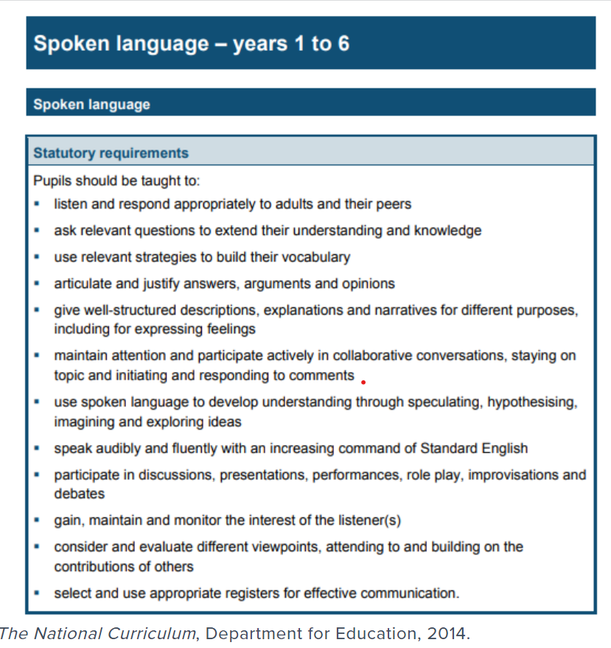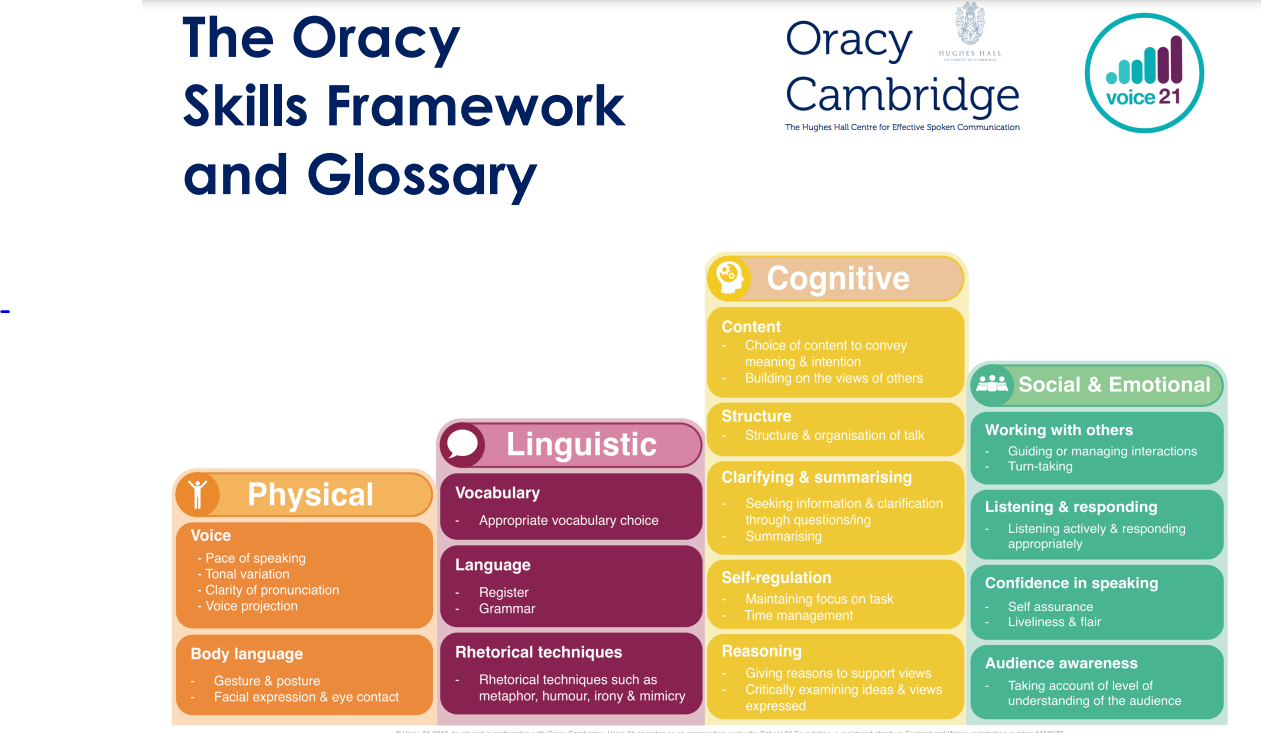Oracy
What is Oracy?
Oracy is the ability to communicate effectively using spoken language.
At Pinders Primary, we want all children to be able to talk with confidence and to articulate themselves clearly.
This short video that explains what Oracy is and how important Oracy, and the teaching of Oracy is. Click on the image below to view this video.
Child friendly explanation of oracy - Click on the image below to view this video.
What do we need to teach?
In statutory terms, the Spoken Language elements of the National Curriculum (2014) outline expectations for the teaching of Oracy.

At Pinders Primary School, we know that aside from the statutory objectives of the National Curriculum, it is important to also teach children other aspects of Oracy. Children need to be taught:
- The ‘rules’ of social interaction – taking turns; identifying who is holding the conversation and how to judge when this can change; how pairs of language work, e.g. Q and A, greeting and response; how to fix what we say or what we don’t understand.
- Non-verbal cues – voice; volume; intonation; eye contact; pitch; pauses; pronunciation; posture; personal space.
- How to listen.
- How to speak.
Our Oracy curriculum is based on the Oracy strands developed by Voice 21 and Cambridge University.
The four strands of Oracy are:
- Physical
- Social and emotional
- Linguistic
- Cognitive
Voice 21, whose Oracy framework is depicted here:

Physical Oracy strand
The physical strand of oracy is about how you present yourself when talking. It's about how you use your voice when you are speaking. It's also about your body language and if you make eye contact.
It includes:
- Voice
- Fluency and pace
- Expression and tone of voice
- Projection
- Eye contact
- Facial expression
- Body language
- Posture
- Gesture
Linguistic oracy strand
The linguistic strand of oracy is about the words you choose to use and how you deliver those words.
It includes:
- Vocabulary choice
- Language variety
- Structure and organisation
- Rhetorical techniques
Cognitive strand of oracy
The cognitive strand of oracy is all about the thoughts you have and the questions you ask during discussions.
It includes:
- Content of talk and audience awareness
- Clarifying and summarising
- Self regulation - Maintaining focus on a task
- Reasoning - justifying and responding to other points of view
Social and emotional strand of oracy
The social and emotional strand is about how we interact with others when communicating.
It includes:
- Working with others
- Listening and responding
- Confidence in speaking
- Audience awareness
Oracy at home
We know it is essential that children continue to develop their Oracy skills at home and in different contexts outside of school. The most important thing parents can do is to talk with their children and encourage them to think and express themselves. Research shows that children who are able to express themselves and construct an argument are better able to progress in other areas of learning such as reading and writing.
Easy things you can do:
- Making eye contact with your child will help your child to focus when you are speaking to them. Body language is so important when talking to your child, as it shows your child that you are interested in what they are saying.
- Face your body towards your child to show them you are engaged in the conversation.
- Expect your child to be polite and model being polite.
- Speak to your children the way you want them to speak to you.
- Remind your child to say please and thank you.
- Encourage your child to speak in full sentences. When your child asks for something, repeat back their request using a full sentence so that you are modelling the language you want them to use.
What else can I do to help?
7 ways to promote oracy at home:
Try these techniques to help your child become a more confident communicator, in school and at home.
1. Read aloud to your child
Reading aloud to your child, well beyond the age they can read for themselves, combines the benefits of talking, listening and storytelling within one activity that helps children build their vocabulary, learn to express their thoughts, and understand the structure of language.
2. Record a video diary
Many children aspire to being vloggers or YouTube stars, so encourage them to start a video diary, either to chart their everyday life or to record special occasions like birthdays and holidays. For safety’s sake, keep these within the family rather than broadcasting them online.
3. Play word games
Games like 20 Questions, Guess Who? and I Spy are great for helping children use descriptive language and think critically about what they’re saying.
4. Talk about their day
Ask your child, ‘What did you do today?’ and they’ll often claim they can’t remember, so find different ways to talk about what they’ve been up to. Eating your evening meal as a family is a good way to encourage conversation, while older kids are often more chatty in the car, where they feel less like they’re being interrogated. You could also try our tips for asking the right questions to elicit information.
5. Phone a friend (or relative)
Persuade your child to take a break from text and WhatsApp and develop their speaking skills by making an actual phone call. Encouraging them to speak to different family members on the phone or on a video call will build confidence.
6. Go on a nature walk
This is a great pre-phonics activity for young children, who can be encouraged to listen carefully to the sounds they hear – from traffic to birdsong – and describe them. They can also describe the natural sights they see, such as trees, animals and birds and the sky.
7. Sign them up for a club
Joining extracurricular clubs is a good opportunity for your child to converse with different people outside the home or school environment. Many of them also involve taking instructions (such as being coached in sporting techniques or to complete science or art projects), and introduce them to different vocabulary relating to their new hobby.
